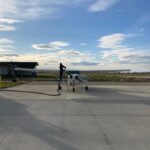Disclaimer: We’re not financial advisors and this isn’t financial advice. It’s just the kind of perspective we wish someone had given us before we started writing checks for flight hours.
Flight training costs real money—usually more than you expect and often more than you can afford to burn casually. But you don’t need to take out a second mortgage or get locked into a $90,000 “airline academy” that promises a job they’ll never actually quite guarantee. You need a plan, discipline and a realistic understanding of how this game works.
Step 1: Don’t Borrow $90,000 You Don’t Have
If a flight school’s sales pitch includes “airline connections,” “guaranteed interviews,” or “career placement,” laugh. None of that is guaranteed (a rejection from that interview they promise is just as likely) and borrowing six figures to chase a maybe-job is a fast track only to long-term debt for short-term bragging rights. Become a qualified and safe pilot and go find a job. Many cadet programs don’t require going to a specific school.
Step 2: Cut Living Expenses Before Cutting Corners
Housing and food often eat more of your flight training budget than fuel ever will because students can’t adapt their lifestyle. Move in with roommates. Skip the new car. Learn to cook something besides ramen. (Or learn to cook ramen really well if that’s your thing.) At The Flight School at Meadow Lake, we offer crash-pad style housing from $200/week or single rooms from $350/week — because sleeping near the airport means flying more and spending less.
Step 3: Work, Don’t Just Borrow
If you can pick up part-time work while you train, do it. Every dollar earned is one less borrowed. Especially aviation jobs. Some schools even offer work-for-training programs; ask if your flight school needs dispatchers, maintenance assistance or operations assistants. You’ll gain experience, networking connections and reduce your training cost at the same time.
Step 4: Study Hard (Before You Pay Someone to Teach You)
Every minute your instructor spends explaining what you could’ve learned at home is money gone forever. Buy an online ground school, knock out your written exams early and study relentlessly. Ground instruction is necessary, but it shouldn’t become a weekly therapy session on how the magnetic compass works. Use your instructor for what only they can provide: real-world context, flight application and feedback.
Step 5: Show Up Early, Preflight Early, Learn Efficiently
Once your instructor shows you how to preflight, start arriving 30 minutes early. Be ready before their meter starts running. Same for lessons: show up prepared, chair-fly the lesson the night before and review the objectives. Every wasted tenth of an hour adds up, and those are hours you could’ve used to go somewhere new or build cross-country time.
Step 6: Use Credit Wisely (And Only If You Actually Understand It)
You might’ve heard of credit card schemes that can earn you rewards and cashback that can reduce the price of…well, anything, but in this case flight training. Credit card bonuses can save you money if the sign-up bonus exceeds the card’s fees and you pay off the balance in full every month. Never carry a balance. Flight training debt accrues fast enough without compounding interest dogfighting you at 29.99% APR. If you borrow money some other way, be smart about rates and anticipate payments well. Don’t over-leverage yourself, because nothing in this industry is guaranteed.
There are flight instructors out there on food stamps because they borrowed six figures to pay for flight training and now they’re trying to pay off a $2,400 monthly payment while making what a flight instructor makes (not a lot at the best schools). Don’t fall into that trap. Understand what you’re getting yourself into before you sign up for “deferred payment plans” or wild financial schemes someone came up with to take your money.
Step 7: Find Scholarships and Grants
There are dozens of aviation scholarships out there, but you’ll never get one you don’t apply for. Women in Aviation, AOPA, EAA and even some local FBOs award funds every year that receive far too many applicants because other people are lazy. You aren’t, so apply. Worst case, you wasted an hour writing an essay. Best case, you save thousands. The Flight School at Meadow Lake gives additional discounts when you’re paying with a scholarship.
Step 8: Understand the Time Value of Money
Delaying training to “save up” can sometimes cost you more than it saves. Inflation, lost proficiency and changing FAA requirements add up over time. But that doesn’t mean you should sprint through training blind. Strike a balance: plan your financing so you can maintain consistent training momentum without stopping every few weeks to wait for the next paycheck or go to work for a while.
Step 9: Choose a Flight School That Values Your Money Like You Do
Some schools run on the philosophy that if you don’t know how to ask for efficiency, you’ll just pay more for inefficiency. The Flight School at Meadow Lake believes in transparency and affordability. Our time-building program is one of if not the most affordable in the country: $55/hour wet (fuel included) when prepaid in a 50-hour block. Our training programs are also the most affordable we’ve found: Zero to CFII for less than $43,000. Our goal isn’t to sell you the “dream.” It’s to make you a pilot without financially destroying you in the process. Pilots above profit!

Step 10: Keep Perspective
Flight training is expensive. That’s reality. But being smart about it can save you thousands and oftentimes tens of thousands. Plan, prepare and be brutally honest about your spending habits. You’ll get your certs faster, safer and with enough money left to buy the fancy instant noodles instead.
Final Thoughts
Budgeting for flight training is a pain in the ass. Be smart, be skeptical and treat every dollar like a flight hour you’re trying not to waste. The payoff isn’t just your certificate, it’s the freedom to fly without financial regret intercepting you at every turn.





